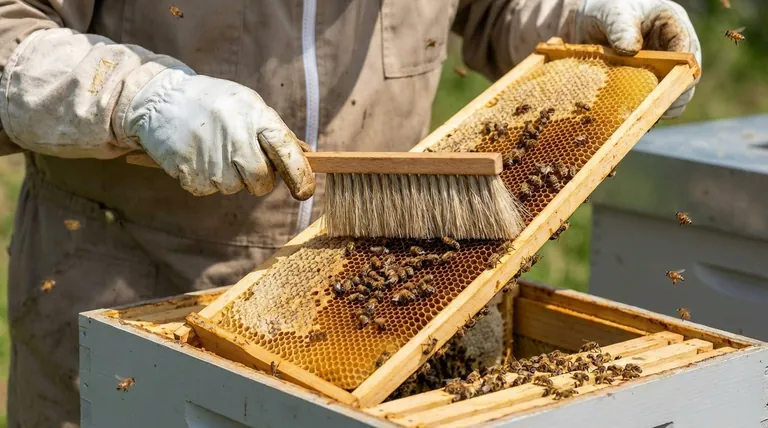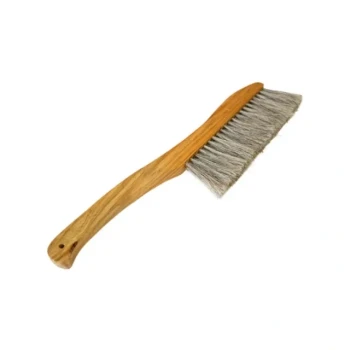At its core, a high-quality hair brush is defined by its materials and construction. You should expect to see a brush made with a solid wooden handle and thick, densely packed bristles. Crucially, these bristles must be very firmly set into the handle to ensure they do not fall out during use, which is a key indicator of durability and premium quality.
The question is not simply about the design of a hair brush, but about finding the right tool for a beekeeper. The qualities that define a high-quality brush—gentleness, durability, and reliability—are the same qualities essential for a tool used to safely manage a honeybee colony.

The Purpose of a Brush in Beekeeping
A specialized brush, known as a bee brush, is a fundamental tool for any beekeeper. Its purpose is not for grooming, but for gently and safely moving bees.
During Hive Inspections
When inspecting a hive, you often need to clear bees from a specific area of a frame to check for the queen, look for eggs, or assess the health of the brood. A soft brush allows you to do this without harming the bees.
During Honey Harvest
When you remove frames of honey, they are covered in bees. A bee brush is the primary tool for gently sweeping the bees off the honeycomb and back into the hive before you take the frames for extraction. Using the wrong tool can injure bees and agitate the colony.
Key Design Features for a Bee Brush
The principles of a high-quality brush align directly with the needs of a beekeeper. The materials and construction are chosen with the safety of the bees and the effectiveness of the task in mind.
Bristle Softness and Density
The references mention "thick bristles," which in a beekeeping context means a high density of very soft bristles. They must be gentle enough to not damage a bee's delicate wings or legs.
Natural bristles, such as long horsehair, are often preferred for their exceptional softness. High-quality synthetic bristles can also be effective if they are designed to be soft and flexible.
Handle Construction and Material
A wooden handle is the standard for a reason. It provides a firm, natural grip, even when you are wearing beekeeping gloves. Wood is also durable and will last for many seasons.
The handle should be long enough to allow you to brush bees from an entire frame with just a few sweeps, minimizing disruption to the hive.
Secure Bristle Setting
This is a non-negotiable feature. The bristles must be firmly set into the handle. If bristles fall out, they can get stuck in the honeycomb, contaminating the honey.
Loose bristles left in the hive can also irritate the bees, potentially being treated as foreign debris that needs to be removed, causing unnecessary stress within the colony.
Understanding the Trade-offs: Bee Brush vs. Other Tools
While it may be tempting to use a different type of brush, it is critical to understand the risks involved. A purpose-built tool is almost always the superior choice.
Why Not a Paint Brush?
Most paint brushes, even those with natural bristles, are too stiff. Their bristles are often cut flat, which can crush or injure bees as you brush them. A proper bee brush has long, flexible bristles that sweep rather than push.
Why Not a Household Brush?
A common household dusting brush may seem soft, but its bristles may shed easily. Furthermore, you cannot be certain that the bristles haven't been treated with chemicals that could be harmful to your bees or contaminate your honey.
The Risk of Agitating the Colony
Using a harsh or inappropriate tool will be perceived as an attack by the bees. This will trigger a defensive response, making your work more difficult and increasing the risk of stings. A gentle, dedicated bee brush keeps the colony calm.
Making the Right Choice for Your Apiary
Your choice of brush directly impacts the well-being of your bees and the efficiency of your work.
- If your primary focus is maximum bee safety: Choose a brush with long, soft, natural bristles like horsehair, which is widely considered the gentlest option.
- If your primary focus is durability and ease of cleaning: A brush with a wooden handle and high-quality, soft synthetic bristles is a reliable and effective choice that is often easier to wash.
- If you are a beginner on a budget: Avoid repurposed household brushes and invest in an entry-level, purpose-built bee brush. The small cost is a worthwhile investment in the health of your colony.
Choosing the right tool is a core part of responsible and effective beekeeping.
Summary Table:
| Key Feature | Why It Matters for Beekeeping |
|---|---|
| Soft, Dense Bristles | Prevents injury to bees' delicate wings and legs during brushing. |
| Solid Wooden Handle | Provides a secure, comfortable grip, even with gloves on. |
| Firmly Set Bristles | Ensures bristles don't fall out and contaminate honey or irritate the colony. |
Equip your apiary with the right tools for gentle and efficient hive management. HONESTBEE supplies durable, high-quality beekeeping brushes and equipment designed for the needs of commercial apiaries and distributors. Our wholesale-focused operations ensure you get reliable tools that protect your bees and streamline your workflow.
Contact HONESTBEE today to discuss your equipment needs and wholesale pricing.
Visual Guide

Related Products
- Wooden Bee Brush with Double-Row Horsehair Bristles
- Wooden Bee Brush with Triple Row Artificial Fiber for Beekeeping
- Classic Wooden Bee Brush with Double-Row Boar Bristles
- Premium Triple-Row Horsehair Bee Brush
- Double Row Artificial Fiber Bee Brush for Beekeeping
People Also Ask
- What is the primary use of a bee brush during inspections and extraction? Essential for Gentle Bee Handling
- What are the characteristics of the bristles on a bee brush? Designed for Gentle Persuasion, Not Force
- What should be done if the swarm is situated on the bottom of a tree limb? A Guide to Methodical Bee Capture
- How effective are brushes as a smoke alternative in beehives? Avoid Agitating Your Hive
- What is a bee brush used for? Gently Sweep Bees from Honeycomb Frames



















